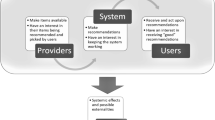Abstract
Recommender systems support users by generating potentially interesting suggestions about relevant products and information. The increasing attention towards such tools is witnessed by both the great number of powerful and sophisticated recommender algorithms developed in recent years and their adoption in many popular Web platforms. However, performances of recommender systems can be affected by many critical issues as for instance, over-specialization, attribute selection and scalability. To mitigate some of such negative effects, a hybrid recommender system, called Relevance Based Recommender, is proposed in this paper. It exploits individual measures of perceived relevance computed by each user for each instance of interest and, to obtain a better precision, also by considering the analogous measures computed by the other users for the same instances. Some experiments show the advantages introduced by this recommender when generating potentially attractive suggestions.




Similar content being viewed by others
References
Adomavicius, G., & Tuzhilin, A. (2001). Using data mining methods to build customer profiles. Computer, 34, 74–82.
Adomavicius, G., & Tuzhilin, A. (2005). Toward the next generation of recommender systems: a survey of the state-of-the-art and possible extensions. IEEE Transactions on Knowledge and Data Engineering, 17(6), 734–749.
Balabanovic, M., & Shoham, Y. (1997). Content-based, collaborative recommendation. Communication of the ACM, 40(3), 66–72.
Berkhin, P. (2006). A survey of clustering data mining techniques. In J. Kogan, C. Nicholas, M. Teboulle (Eds.), Grouping multidimensional data pages (pp. 25–71). Springer-Verlag.
Breese, J., Heckerman, D., Kadie, C. (1998). Empirical analysis of predictive algorithms for collaborative filtering. In Proceedings of the 14th international conference on uncertainty in artificial intelligence (pp. 43–52). Morgan Kaufmann.
Buccafurri, F., Palopoli, L., Rosaci, D., Sarńe, G.M.L. (2004). Modeling Cooperation in Multi-Agent Communities. Cognitive Systems Research, 5(3), 171–190.
Burke, R.D. (2002). Hybrid recommender systems: Survey and experiments. User Modeling and User-Adapted Interaction, 12(4), 331–370.
Burke, R.D. (2007). Hybrid web recommender systems. In The adaptive web, volume 4321 of LNCS (pp. 377–408). Springer.
Chan, P.K. (2000). Constructing web user profiles: A non invasive learning approach. In Web usage analysis and user profiling, volume 1836 of LNCS (pp. 39–55). Springer.
Claypool,M., Gokhale, A., Miranda, T., Murnikov, P., Netes, D., Sartin,M. (1999). Combining content-based and collaborative filters in an online newspaper. In Proceedings of ACM SIGIR work on recommender systems (vol. 60). ACM.
de Campos, L.M., Fernn̈dez-Luna, J.M., Huete, J.F., Rueda-Morales,M.A. (2010). Combining content-based and collaborative recommendations: A hybrid approach based on Bayesian networks. International Journal of Approximate Reasoning, 51(7), 785–799.
Gunawardana, A., & Meek, C. (2009). A unified approach to building hybrid recommender systems. In Proceedings of the 3rd ACM conference on recommender systems (pp. 117–124). ACM.
Herlocker, J., Konstan J. A., Riedl J. (2002) An empirical analysis of design choices in neighborhood-based collaborative filtering algorithms. Information Retrieval, 5(2) 287–310.
Herlocker, J.L., Konstan, J.A., Borchers, A., Riedl, J. (1999). An algorithmic framework for performing collaborative filtering. In Proceedings of the 22nd annual international ACM SIGIR conference on research and development in information retrieval, SIGIR ’99 (pp. 230–237). New York: ACM.
Hofmann, T. (2004). Latent semantic models for collaborative filtering. ACM Transaction on Information Systems, 22(1), 89–115.
Jain, A. K., Murty, M.N., Flynn, P.J. (1999). Data clustering: A review. ACM Computer Survey, 31, 264–323.
Karypis, G. (2001). Evaluation of item-based top-N recommendation algorithms. In Proceedings of the 10th international conference on information and knowledge management, CIKM ’01 (pp. 247–254). New York: ACM.
Konstan, J., & Riedl, J. (2012). Recommender systems: From algorithms to user experience. User Modeling and User-Adapted Interaction, 22(1), 101–123.
Linden, G., Smith, B., York, J. (2003). Amazon.com recommendations. Item-to-item collaborative filtering. IEEE Internet Computing, 7(1), 76–80.
Liu, D.R., & Liou, C.H. (2011). Mobile commerce product recommendations based on hybrid multiple channels. Electronic Commerce Research and Applications, 10(1), 94–104.
Lops, P., Gemmis, M., Semeraro, G. (2011). Content-based recommender systems: State of the art and trends. In Recommender systems handbook (pp.73–105). Springer.
Manouselis, N., & Costopoulou, C. (2007). Analysis and classification of multi-criteria recommender systems. World Wide Web, 10(4), 415–441.
Melville, P., Mooney, R.J., Nagarajan, R. (2002). Content-boosted collaborative filtering for improved recommendations. In Proceedings of the 18th national conference on artificial intelligence (pp. 187–192). Edmonton: AAAI/IAAI.
Mitchell, T.M. (1997). Machine learning. Burr Ridge, IL: McGraw Hill, 45.
Miyahara, K., & Pazzani,M.J. (2000). Collaborative filteringwith the simple Bayesian classifier. In Proceedings of the 6th pacific rim international conference on artificial intelligence, PRICAI’00 (pp. 679–689). Berlin: Springer-Verlag.
Mobasher, B., Dai, H., Luo, T., Nakagawa, M. (2002). Discovery and evaluation of aggregate usage profiles for web personalization. Data Mining Knowledge Discovery, 6, 61–82.
Montaner, M., Lopez, B., de la Rosa, J.L. (2004). A taxonomy of recommender agents on the internet. Journal on Web Semantics (JWS), 19(4), 285–330.
Rosaci, D., Palopoli, L., Sarné, G.M.L. (2013). Introducing specialization in e-commerce recommender systems. Concurrent Engineering: Research and Applications, 21(3), 187–196.
Parsons, J., Ralph, P., Gallagher, K. (2004). Using viewing time to infer user preference in recommender systems. In AAAI workshop on semantic web personalization (pp. 52–64). Menlo Park: AAAI Press.
Pazzani, M.J. (1999). A framework for collaborative, content-based and demographic filtering. Artificial Intelligence Review, 13(5-6), 393–408.
Popescul, A., Pennock, D.M., Lawrence, S. (2001). Probabilistic models for unified collaborative and content-based recommendation in sparse-data environments. In Proceedings of the 17th conference on uncertainty in artificial intelligence. Morgan Kaufmann Pub.
Postorino, M.N., & Sarné, G.M.L. (2011). A neural network hybrid recommender system. In Proceedings of the 2011 conference on neural Nets WIRN10 (pp. 180–187). Amsterdam: IOS Press.
Rosaci, D., & Sarnè, G.M.L.: (2006). A multi-agent system handling user and device adaptivity of web sites. User Modeling and User-Adapted Interaction, 16(5), 435–462.
Rosaci, D., & Sarnè, G.M.L. (2010). Efficient personalization of e-learning 616 activities using a multi-device decentralized recommender system. Computational Intelligence, 26(2), 121–141.
Rosaci, D., Sarnè, G.M.L., Garruzzo, S. (2009). MUADDIB: A distributed recommender system supporting device adaptivity. ACM Transansacion on Information Systems, 27(4).
Rosaci, D., Sarnè G.M.L., Garruzzo, S. (2012). Integrating trust measures in multiagent systems. International Journal of Intelligent Systems, 27(1), 1–15.
Rosaci, D., Sarnè, G.M.L. (2013). Cloning mechanisms to improve agent performances. Journal of Network and Computer Applications, 36(1), 402–408.
Salter, J., & Antonopoulos, N. (2006). CinemaScreen recommender agent: Combining collaborative and content-based filtering. IEEE Intelligent Systems, 21(1), 35–41.
Schein, A.I., Popescul, A., Ungar, L.H., Pennock, D.M. (2002). Methods and metrics for cold-start recom mendations. In Proceedings of the 25th Annual International ACM SIGIR conference on research and development in information retrieval, SIGIR ’02 (pp. 253–260). ACM.
Shardanand, U., & Maes, P. (1995). Social information filtering: algorithms for automating “word of mouth”. In Proceedings of the SIGCHI conference on human factors in computing systems (pp. 210–217). ACM.
Stiller, C., Ross, F., Ament, C. (2010). Demographic recommendations for WEITBLICK, an assistance system for elderly. In International symposium on communications and information technologies (ISCIT) (pp. 406–411). IEEE.
Su, X., & Khoshgoftaar, T.M. (2009). A survey of collaborative filtering techniques. Advances in Artificial Intelligence, 2009, 4:2-4:2.
Trewin, S. (2000). Knowledge-based recommender systems. Encyclopedia of Library and Information Science, 69(Supplement 32), 69.
van Rijsbergen, C.J. (1974). Foundation of evaluation. Journal of Documentation, 30(4), 365–373.
Wei, K., Huang, J., Fu, S. (2007). A survey of e-commerce recommender systems. In Proceedings of the 13th international conference on service systems and service management (pp. 1–5). Washington: IEEE Computer Society.
Weng, S.S., & Liu, M.J. (2004). Feature-based recommendations for one-to-one marketing. Expert Systems with Applications, 26, 493–508.
Woźniak, M., Graña, M., Corchado, E. (2014). A survey of multiple classifier systems as hybrid systems. Information Fusion, 16, 3–17.
Author information
Authors and Affiliations
Corresponding author
Appendix
Appendix
The Section Appendix presents the two XML-Schema of the Dictionary and of the User Profile described in Section 3.
The Dictionary XML-Schema

The User Profile XML-Schema

Rights and permissions
About this article
Cite this article
Sarnè, G.M.L. A novel hybrid approach improving effectiveness of recommender systems. J Intell Inf Syst 44, 397–414 (2015). https://doi.org/10.1007/s10844-014-0338-z
Received:
Revised:
Accepted:
Published:
Issue Date:
DOI: https://doi.org/10.1007/s10844-014-0338-z




